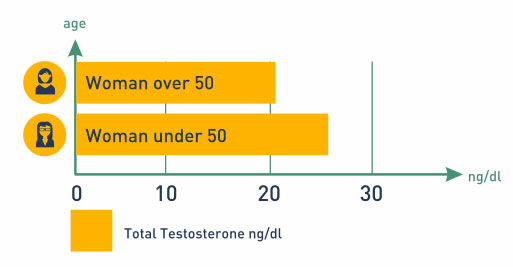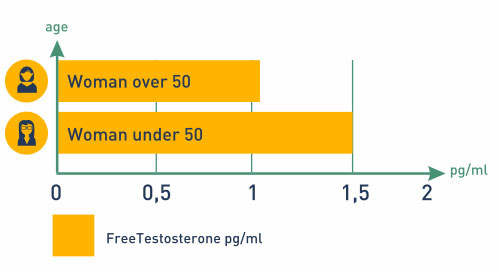Testosterone Levels in Women By Age
Just as with men, determining what is considered to be an acceptable testosterone level in women is often complicated. The wide range of fluctuation in normal testing levels makes it difficult to set an ideal number. Doctors are often left on their own to determine who requires treatment for Low T.
In fact, the guideline for determining normal testosterone levels in women by age varies from one laboratory to another. It is necessary to look to published studies to find answers that can help doctors make a proper decision as to who can be helped by receiving treatment.
According to a report out of Boston University School of Medicine regarding Sexual Medicine cited in 2002, women under the age of 50 can be considered to have Low T if they have a plasma (total) testosterone level of less than 25 ng/dL. Women over 50 are ruled deficient with anything less than 20 ng/dL.
Free testosterone levels under 1.5 pg/mL for those under age 50, and below 1.0 pg/mL for the over 50 female are also indicative of Low T.
Maintaining adequate testosterone levels in women by age will help keep bones strong, metabolism converting food into energy, brain functions sharp, and the heart healthy.
Even if the values of testing testosterone levels in women come in slightly higher than what is considered low by these standards, hormone replacement specialists will look to the symptoms present to make the determination of testosterone deficiency. There are many facets that go into deciding who is an ideal candidate for this treatment.
Low Levels of Testosterone in Women
Testosterone is produced by the ovaries and the adrenal glands in females, where it is then released into the bloodstream. Low testosterone levels in women may occur during primary or secondary ovarian failure. Oophorectomy (surgical removal of the ovaries) may bring a significant (and rapid) decrease in testosterone levels.
According to some reports, menopause typically brings a decline in the production of testosterone. Since this hormone provides a woman with sexual desire, it is understandable that her libido would begin to fall in response. Decreased vaginal lubrication is also responsible for changing desires in terms of intimacy and sexuality. Intercourse may become painful and unenjoyable during this time.
When experiencing a decline in testosterone levels, women often suffer from many of the same symptoms as men with Low T, including:
- Weight gain
- Mood swings
- Loss of lean body mass
- Reduced strength
- Decreased bone density
- Hair loss
- Poor sleep
- Declining memory
- Difficulty with focus and concentration
- Depression
- Low libido
- Hot flashes
Treatment with testosterone cream has shown exceedingly beneficial for women dealing with the symptoms associated with Low T.
Normal Levels of Testosterone in Women
As previously mentioned, assessing what is to be considered as acceptable testosterone levels in women is not always easy. There are no set national guidelines, and the fact that laboratories and medical centers can each have their own set of standards makes this type of diagnosis all that much more difficult.
Although the National Institutes of Health have placed the normal testosterone levels in women at 30 – 95 ng/dL, other reports from different laboratories state that it can be anywhere from 8 – 60 ng/dL or 15 – 70 ng/dL for total testosterone readings. This discrepancy can make it difficult for doctors who are not hormone replacement therapy specialists to know when and how to treat a female for Low T.
| Age | Female T Level (ng/dL) |
| 0-5 months | 20-80 |
| 6 mos.-9 yrs. | <7-20 |
| 10-11 yrs. | <7-44 |
| 12-16 yrs. | <7-75 |
| 17-18 yrs. | 20-75 |
| 19+ yrs. | 8-60 |
| Avg. Adult | 15-70 |
| Over 60 years | 35 |
The HRT specialist will also monitor the level of free testosterone to be between 0.3-1.9 ng/dL. In addition, the level of testosterone that is bioavailable in the body for a woman between the ages of 20 and 50 years who is not on oral estrogen should be 0.8-10 ng/dL. Someone who is on oral estrogen should have a reading between 0.8-4.0 ng/dL.
Testosterone levels are at their lowest points in women during puberty and adolescence, and at their highest during the pre and post-menopausal periods. That is why low levels during menopause can cause such distressing symptoms. Since women naturally create much lower levels of testosterone, they are more sensitive to changes in androgens than men.
High Levels of Testosterone in Women
Although any number of reasons can cause a woman to produce too much testosterone, one problem, in particular, can lead to this situation. A condition called PCOS – polycystic ovarian syndrome can induce high levels of testosterone in women. A woman may have an apple shaped body or be dealing with obesity in cases of PCOS. Ovarian tumors can also elevate testosterone secretion.
Some of the possible symptoms of high testosterone levels in women are:
- Oily skin or acne
- Loss or thinning of scalp hair, frontal balding
- Enlarged clitoris
- Excess growth of facial hair
- Infertility
- Irregular periods or menstrual cessation
- Deepening of the voice
- Increased muscle mass
Elevated testosterone levels in women may also lead to carbohydrate intolerance that increases weight gain, insulin resistance, high LDL and low HDL cholesterol levels, raised triglycerides, and high blood pressure.
As a woman ages, dealing with PCOS may increase the risk of developing heart disease. The effects associated with this condition, and the symptoms of high testosterone levels for women can create many problems that may lead to depression. It is just as important to seek out medical help for high testosterone levels as it is for when they are low.
Free Testosterone Levels in Women Chart
Free testosterone is important to understand because this is the amount of the hormone available immediately for the body’s use. Once testosterone is released into the bloodstream, it attaches to one of two substances:
- Sex hormone-binding globulin (SHBG)
- Albumin
When testosterone is bound to SHBG, it is not able to join with its receptor cells in the body’s tissues. It must first detach itself from the SHBG to be considered free and available for use. The albumin-bound testosterone connection is weak, so it easily dissociates in the capillary bed and is readily available for use and uptake by the tissues.
Normal female free testosterone levels can be found in the chart below:
| Normal Free Testosterone Levels | PG/ML |
| Women Under Age 50 | Over 1.5 pg/mL |
| Women Over Age 50 | Over 1.0 pg/mL |
Testosterone Levels in Postmenopausal Women
Female hormone imbalance is relatively common, especially once menopause strikes. At this time, the ovaries no longer produce crucial chemicals that the body needs. These hormones are still required throughout life to maintain strong bones and muscles, support brain and heart functions, and keep an active libido.
The list of female hormones produced by the ovaries includes:
- Progesterone
- Testosterone
- Estrogen
While the adrenal glands still help out with testosterone and progesterone production in later years, the amount supplied is extremely small. The biggest issue that we see is an end to normal estrogen levels when the body converts excess testosterone into estradiol. This causes an imbalance that leads to a condition called estrogen dominance – where estrogen is now unopposed by progesterone and testosterone because their levels have declined. Estrogen dominance leads to weight gain, which further increases testosterone to estrogen conversion.
Here is how to tell if a woman has high estrogen and low testosterone and progesterone after menopause:
- Weight gain
- Decreased sex drive
- Fibrocystic breasts
- Mood swings and depression
- Bloating
- Headaches
- Hair loss
- Fatigue
- Insomnia
- Foggy headedness
- Thyroid dysfunction
When it comes to low levels of testosterone in females, treatment with a prescription compounded cream can safely raise testosterone back into the normal range.





